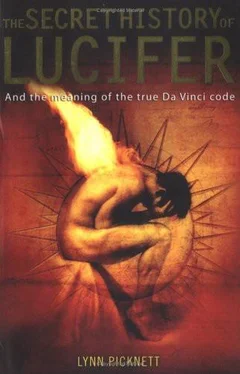Eve was much easier to cope with, although being a woman she still managed to get expelled from Paradise for bad behaviour. (But, as Jeffrey Burton Russell notes, although `The story of Eden readily lent itself to an attack on women ... In fact no good reason existed for blaming Eve for original sin any more than Adam .1)2
Lilith is no longer found in the Bible, but she resurfaced in medieval times as nothing less than the Devil's mother, `In parody of the Blessed Mother and the angels, she joins the ranks of demons singing praises round the throne of her son. '3In another version of her later myth, she and her daughters, the ilim, continued to wreak havoc in men's lives as lustful she-devils whose nightly attacks caused nocturnal emissions, against which medieval Jews carried talismans. (Like their notorious mother, the ilim always squatted on top of their male victims, apparently adding to the horror.) Christian monks lived in terror - or so they claimed - of an attack from `the harlots of hell', or succubae, and slept with hands holding a crucifix uncomfortably crossed over their genitals to ward them off. `It was said that every time a pious Christian had a wet dream, Lilith laughed ...'4 We may be amused at such an unsophisticated interpretation of a natural physiological phenomenon, but it must be remembered that to good Christian men, this was a truly terrifying attack, for they believed their souls were being sucked out of them together with their semen. Lilith's daughters - also called Lamia, Hora, Daughters of Hecate among other titles - caused `men to dream of erotic encounters with women, so the succubae can receive their emission and make therefrom a new spirit .15
In fact, one common name for the succubae was Brizo, after the Greek goddess of dreams whose title, in turn, came from brizein, `to enchant'. `Like Babylon's dream-goddess Nanshe, Brizo brought prophetic dreams which were subsequently identified as "wet" dreams.'6
Lilith and her brood were also designated as `night hags', actually beautiful succubae whose lovemaking expertize was so exquisite that once mortal men experienced it they could never be satisfied ever again by coupling with ordinary human women. But she-devil though she may be, Lilith's continuing power over both Jewish and Christian imaginations was clearly intense. As A. T. Mann and Jane Lyle write in their classic Sacred Sexuality (1995): `In the Pyrenean cathedral of St-Bernard-de-Comminges, Lilith has found her way into a church: a carving there depicts a winged, birdfooted woman giving birth to a Dionysian figure, a Green Man." Dionysus was a middle-eastern rustic wine-god whose ceremonies included drunken orgies in which his priestesses, the Maenads, tore men to pieces.
The same area in the south of France where Lilith may be found in church has legends of Herodias - the wife of Herod who made Salome ask him for John the Baptist's head - having ended her days by drowning in a local stream. After which, she joined her sisters, the night hags, and still waits to swoop down on the unwary male traveller.
Of course there was a male version of the succubae, the incubae which lay with women as they slept. In medieval times it was often said that nuns awoke `to find themselves polluted as if they had slept with men's - in many, if not most, cases because they actually had. Some quick-thinking nuns claimed they had slept with Christ (possibly many believed that they had), but this was swiftly denounced as blasphemy resulting from demonic possession, despite the fact that they were known as `Brides of Christ'.
Predictably, women who were believed to consort with demons - as we will see - caused more fear and horror among the Godfearing than the imps of Hell themselves. An Anglo-Saxon book suggested the use of magic potions - or rather `holy salves' - not against the incubi themselves but against the women with whom Satan had allegedly fornicated. In Toulouse in the south of France in 1275 a woman of 56 was tortured until she confessed to nightly romps with an incubus and having given birth to `the demon's child, which was half wolf and half snake'' But as Barbara Walker notes grimly: `Perhaps the ultimate irony was the church's official opinion that all the activities of incubi were performed "with the permission of God ".10 But what God allowed, men punished."'
All that was in the bleak future, when men had discovered how to deal with the daughters of Eve and Lilith. Back at the beginning of all things, however, even Yahweh clearly had no idea how to cope with the latter bad girl - it seems never to have occurred to him to adopt the smiting mode that distinguished his later career - and his angels appear to have been similarly impotent in the face of her feisty response. Perhaps the Lord should have sought advice about how to deal with Lilith from his wife, who was already a force to be reckoned with in the ancient world. American Scholar William G. Denver wrote in 1984:
Recent archaeological discoveries provide both texts and pictorial representation that for the first time clearly identify `Asherah' as the consort of Yahweh, at least in some circles in ancient Israel ... We cannot avoid the conclusion that in Israel Yahweh could be closely identified with the cult of Asherah, and in some circles the goddess was actually personified as his consort.12
Excavations at Ras Sharma (ancient Ugarit) have unearthed 14thcentury BCE tablets on which it states that the `wife of El', the `Progenitress of the God', or Asherah, was one and the same as most Mother Goddesses, including the Sumerian goddess Astarte" and the Phoenician Tanit, whose temple in Carthage was called the Shrine of the Heavenly Virgin, while the Greeks and Romans referred to it as a `temple of the moon'.14 Elath, on the coast of the Gulf of Aqaba, may have been named after the great goddess, who was clearly celebrated as the personification of the Feminine Principle throughout the Near and Middle East. Walker writes:
In Egypt [Asherah] was also a Law-giving Mother, Ashesh, an archaic form of Isis; the name meant both `pouring out' and `supporting', the functions of her breasts. Her yonic shrine in Thebes was Asher, Ashrel, or Ashrelt. Some called her `Great Lady of Ashert, the lady of heaven, the queen of the gods."5
The Canaanites called her Qaniyatu elima or `She Who Gives Birth to the Gods', or Rabbatu athiratu yammi, Lady Who Traverses the Sea - in other words, the Moon.16 All three major manifestations of the Great Mother were associated with the three phases of the Moon: the Virgin goddess with the New Moon, the Mother with the full Moon, and the crone or older wise woman with the dark of the Moon. Significantly, too, as Barbara Walker notes, `Rabbatu was an early female form of rabbi'." Wife of God and a rabbi! To the grey-bearded patriarchs this situation could not be allowed to last, whatever God's own views on the subject. (There is archaeological evidence that it was common for blessings to be invoked `by Yahweh and his Asherah','" a turn of phrase that implies a touching, even tender, closeness.) Clearly Asherah's days of power were numbered.
Walker writes dryly: `For a while, Asherah accepted the Semitic El as her consort' - a nice reversal of the usual situation with females in the Near East, especially in ancient times. Walker continues: `She was the Heavenly Cow, he the Bull." After their sacred marriage, she bore the Heavenly Twins, Shaher and Shalem, the stars of morning and evening ...'20
As noted in Chapter One, the Morning Star was none other than Lucifer - and in this legend, literally the son of God. As the heir to the divine dynasty, his challenge to paternal authority can be seen in the context of the sacred kings of the Near and Middle East. The outgoing priest-king, possessed of magical powers and totemic representative of his tribe is ritually challenged - and often slain - by his successor. But Yahweh's priesthood was disinclined to permit its King-god to be challenged, and in any case rapidly buried the idea that God had a wife, let alone a child or children. Everything about Asherah soon became anathema - even the cooking of a kid in its mother's milk," which was believed to have been involved in her marriage ceremony to Yahweh.
Читать дальше












